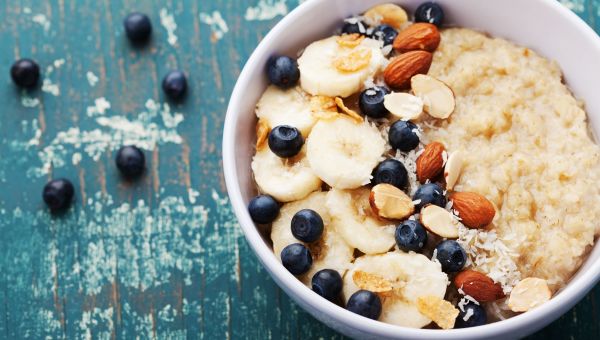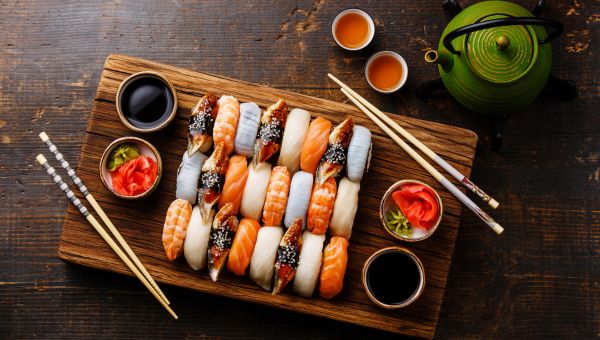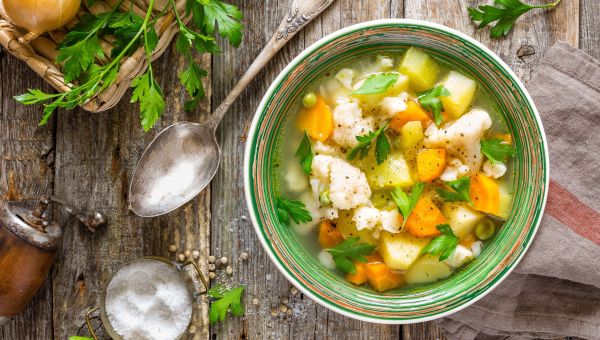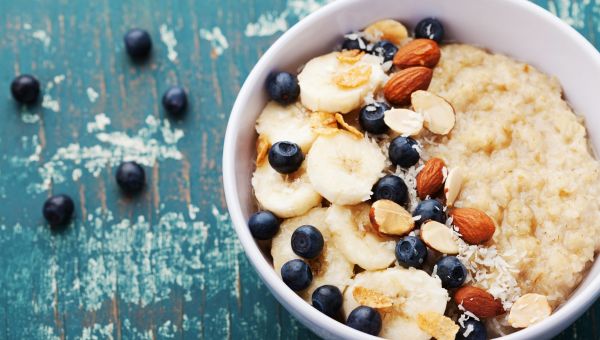5 food combos that may promote weight loss
Feel fuller, longer after enjoying these delicious bites.
Updated on November 16, 2022

When it comes to losing weight, sometimes two foods are better than one. These delicious pairings can sate your appetite, stave off hunger, and help you potentially consume fewer calories—key to dropping pounds.

Sushi & green tea
The sushi bar is a great place to grab a wholesome, balanced meal—you just have to know what to order. To start, consider a roll that's filled with fish rich in omega-3 fatty acids, like salmon or tuna. Omega-3 fatty acids are considered ‘healthy fats’ and research suggests they may increase metabolism.
Looking for a vegetarian-friendly option? Try avocado, a good source of healthy fats and fiber, which helps you feel fuller, longer. Cucumbers are a fresh and light addition, as well; 1 cup of chopped cucumber is just 13 calories.
Wash it all down with a cup of green tea, which some research suggests may help you drop pounds by boosting your metabolism. Keep in mind: Though green tea is believed to have health benefits, its effect on weight loss is still under investigation.
Limiting or avoiding deep-fried tempura or “spicy” rolls—which are often made with mayonnaise—can help cut down on extra calories and. Consider swapping out white rice for brown rice, too, since brown rice is more nutrient-dense.

Avocado toast & eggs
This trendy breakfast is popular for good reason—it's a delicious way to keep you sated in the morning. One reason is its high protein content; a single sunny side-up egg contains about 6 grams of protein.
Pair your egg with a slice of whole-wheat toast for a carb-fueled energy boost. Slices of avocado provide healthy fats and are also a good source of fiber, folate, potassium, magnesium, B vitamins, and vitamins C and E.

Soup & salad
Because soup can take on many forms, generalizing its effects on weight loss is difficult. There is some evidence, however, that regularly eating soup is linked to lower calorie intake and a healthier diet overall—people who eat soup may consume less fat and get more protein and fiber. Soup may also delay the emptying of food from the stomach if you eat it before a larger meal, so you feel fuller for an extended period.
If you’d like to incorporate soup into a weight-loss plan, start with a broth-based soup like lentil or butternut squash soup. Load your soup with nutrient-dense foods like beans and vegetables; minestrone, pasta e fagioli, and mushroom barley soup can be wise options. Lean away from cheesy or cream-based soups, such as restaurant-style lobster bisque and New England clam chowder. Know that store-bought canned soups tend to be very high in sodium, as well.
Pair your soup with a salad that includes ingredients high in fiber and protein. Topping greens with ingredients like quinoa, chickpea, and almonds may do the trick.

Oatmeal & nuts
This classic breakfast is a smart and easy way to start your day on the right foot. Fueling up on fiber-rich oatmeal can help you feel full while cutting back on inflammation, which has been linked to obesity. Oatmeal could also help lower LDL (“bad”) cholesterol, and is a good source of phytonutrients, or chemicals found in plant foods that may have additional health benefits. Just be careful of which oatmeal you choose: While both rolled and steel cut oatmeal offer roughly the same advantages, instant oatmeal often includes added sugars and preservatives.
Once your oats are cooked, add even more fiber by topping them off with chopped fruits, pureed pumpkin, a dollop of nut butter, or nuts like almonds, walnuts, or pistachios. The nuts provide a dose of healthy fats, too.

Spicy chicken & beans
A savory trio of beans, chicken, and peppers can be a diet-friendly dinner. Chicken breast contains 32.1 grams of protein per 3.5-ounce serving, while clocking in at only 166 calories. The protein can help satisfy you, reducing the temptation to reach for dessert or for seconds.
Tap into the power of legumes by pairing your chicken with beans. Loaded with protein and fiber, these tiny powerhouses have frequently been linked to weight loss and can help lower your LDL ("bad") cholesterol, as well.
Finally, add some serious spice to your dish with jalapenos or cayenne. Some research suggests capsaicin in hot peppers may slightly speed up your metabolism and could potentially reduce appetite. But note that the research behind capsaicin’s effects is still underway.

Du S, Jin J, et al. Does Fish Oil Have an Anti-Obesity Effect in Overweight/Obese Adults? A Meta-Analysis of Randomized Controlled Trials. PLoS One. 2015 Nov 16;10(11):e0142652.
Punia S, Sandhu KS, Siroha AK, et al. Omega 3-metabolism, absorption, bioavailability and health benefits–A review. PharmaNutrition. 2019;10, 100162.
Hursel R, Viechtbauer W, Westerterp-Plantenga MS. The effects of green tea on weight loss and weight maintenance: a meta-analysis. Int J Obes (Lond). 2009 Sep;33(9):956-61.
Phung OJ, Baker WL, et al. Effect of green tea catechins with or without caffeine on anthropometric measures: a systematic review and meta-analysis. Am J Clin Nutr. 2010 Jan;91(1):73-81.
Zhang Y, Yu Y, et al. Effects of catechin-enriched green tea beverage on visceral fat loss in adults with a high proportion of visceral fat: A double-blind, placebo-controlled, randomized trial. Journal of Functional Foods. January 2012. 4(1): 315-322.
Dinh TC, Phuong TNT, et al. The effects of green tea on lipid metabolism and its potential applications for obesity and related metabolic disorders – An existing update. Diabetes & Metabolic Syndrome: Clinical Research & Reviews. March–April 2019. 13(2): 1667-1673.
Cleveland Clinic. The Healthiest Sushi Options You Should Order – And Why. August 25, 2021.
Cleveland Clinic. Why Avocados Are a Healthy — and Delicious — Addition to Your Diet. September 15, 2020.
Academy of Nutrition and Dietetics. Choose Healthy Fats. Reviewed May 2021.
Harvard TH Chan School of Public Health. Avocados. Accessed November 16, 2022.
Zhu Y, Hollis JH. Soup consumption is associated with a lower dietary energy density and a better diet quality in US adults. Br J Nutr. 2014 Apr 28;111(8):1474-80.
Flood JE, Rolls BJ. Soup preloads in a variety of forms reduce meal energy intake. Appetite. 2007 Nov;49(3):626-34.
Clegg ME, Ranawana V, et al. Soups increase satiety through delayed gastric emptying yet increased glycaemic response. Eur J Clin Nutr. 2013 Jan;67(1):8-11.
American Heart Association. Take a fresh look at oatmeal – it's not as simple as you think. September 1, 2022.
North Dakota State University. All About Beans Nutrition, Health Benefits, Preparation and Use in Menus. Reviewed February 2019.
Tucker LA. Bean Consumption Accounts for Differences in Body Fat and Waist Circumference: A Cross-Sectional Study of 246 Women. J Nutr Metab. 2020 Jun 6;2020:9140907.
Zheng J, Zheng S, Feng Q, et al. Dietary capsaicin and its anti-obesity potency: from mechanism to clinical implications. Bioscience Reports. 2017;37(3).
More On


video

article

slideshow


video


video
